Delphi Archaeological Museum
The Museum of Delphi is considered among the three most important museums in Greece, together with the ones of the Acropolis of Athens and in Heraklion, Crete. What makes a visit to the Greek Museums in general, this one in particular, an unforgettable experience, is the fact that they usually exist on the very archaeological site(s), thus putting the exhibits in the surroundings in which they were initially established, in close relevance to their cultural and/or religious role.
The Delphi Museum first opened its doors tο the public in 1903; in the more than 100 years that have elapsed since then, it has been recognized as one of the most important museums in Greece. It has undergone many renovations during this time and four different exhibitions, each reflecting the scientific concepts and artistic standards as they evolved through the 20th century. The quality of the exhibits, though, has always been the main advantage of this Museum.
According to Rosina Colonia, (Delphi Ephorate of Antiquities) “… the Delphi exhibits speak for themselves: they have the power to command respect and captivate the visitor, inviting him or her to admire them, and leaving this visitor with the memory of their charm and the enigma surrounding them. Even though the exhibits on display today constitute no more than a small but representative part of the dedications seen by Pausanias at Delphi, and an even smaller part of the many more that inundated the sanctuary during the years of its heyday, they indisputably continue to delight people with their wealth, variety and beauty. …Delphi has been included in archaeology textbooks, it has adorned art books; some of the Delphi finds, such as the Treasury of the Siphnians, are landmarks in the history of ancient Hellenic art, while others, even though more than one hundred years have elapsed since they came to light, continue to be a focal point of scholarly discussions even today, owing to unanswered questions regarding their identity and interpretation. But above all, they still chaim the broad public who flock, like ancient pilgrims, to admire the monuments of Delphi”. (Quotation ©: John S. Latsis Public Benefit Foundation)
Photos will be gradually added in the near future
Select Page of the Album:
Click on any of the pictures to enlarge.
Small Scale Bronze Sculptures from the Repositories
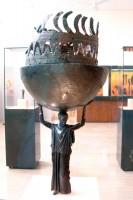
Bronze incense burner
A young woman wearing a long 'peplos' and reticulated head-dress holds up a hemispherical cauldron in which the incense was placed. A pierced lid covers the top of the vessel. A most exquisite creation, most probably the product of a Parian workshop (460-450 BC.) |
|
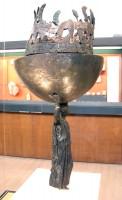
Bronze incense burner
Same exhibit, side view |
|
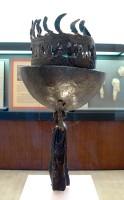
Bronze incense burner
Same exhibit, view of its left side |
|
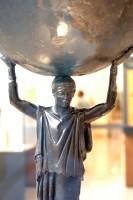
Bronze incense burner
Same exhibit, frontal detail |
|
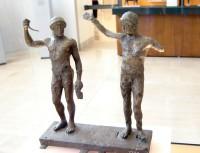
Pair of athletes
The man on the right appears to be proclaiming his younger fellow athlete the victor. The latter is holding ‘halteres’ (hand-held weighs used by competitors in the long-jump event) and the victor’s wreath. A work of an Attic workshop, 460-450 BC. |
|
|
Select Page of the Album:
|
|



